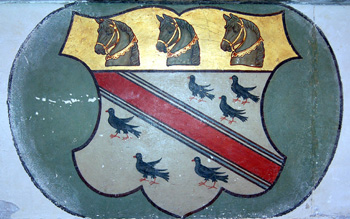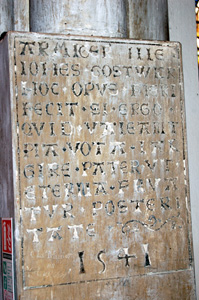Sir John Gostwick

Coat of arms of Sir John Gostwick on his tomb August 2010
Bedfordshire Historical record Society Volume XXXVI of 1956 contained a substantial account of the Gostwick family by H. P. R. Finberg. The family is first mentioned in 1262 when a William de Gostwye was one of the jurors empanelled to ascertain the extent of the holdings of the deceased William de Beauchamp in Stanford.
The first family member recorded in connection with Willington was a Roger de Gostwyke of Willington, juror at an inquisition in Cardington in 1286. In 1298 King Edward I (1272-1307) appointed John de Gostwyk and Roger de Loryng to deputize for Roger Lestrange, who had fallen ill, to sell the timber and find tenants for the waste lands of the royal forests in southern England. As the Crown derived a considerable income from its forests this was clearly an important position and Gostwyk must have been a man of some ability.
John Gostwick was born in Willington, probably some time in the 1480s. He was the son of John and was raised and schooled in Potton. At some time between 1510 and 1514 John Gostwick, presumably in his mid to late twenties or early thirties, was introduced to the almoner to King Henry VIII (1509-1547). This man was none other than Thomas Wolsey and Gostwick entered his service. Wolsey's wardrobe accounts for 1517 state: "to Gostewyk crimson and tawny and black velvet". By that time he was one of the Gentlemen Ushers Extraordinary, sworn to attend the king in his chamber.
As well as a minor courtier Gostwick was a merchant, obtaining a licence in 1514 to "import caps and hats of all colours from Milan, France and Flanders for five years". In 1517 he was described as a wax chandler and was one of those given power to examine and punish "all adulterations in the manufacture of waxen images, torches, candles contrary to statute". Local legend ascribes a helmet and surcoat in Willington church to Gostwick, stating that he wore them at the Field of the Cloth of Gold in 1520 - the meeting between King Henry VIII and King Francis I of France (1515-1547), organised by Wolsey. It is also said that the horse's heads on Gostwick's coat of arms mean he was Master of the Horse either to cardinal Wolsey of Henry VIII. There is no evidence for this legend and the horses heads were later replaced by stars as he became more prominent in the life of the court.

The tilting helm of Sir John Gostwick August 2010
In 1522 he was appointed auditor of thirteen places in Yorkshire at a salary of £10 per annum, Wolsey noting that he had recommended his "old and trusty servant" for the post. In January 1523 John Gostwick "of Wakefield, Yorkshire", was awarded a coat of arms. He leased Braithwaite Manor, near Middleham, in 1524 for £10/3/4 per annum. By this time he was married to Joan, her maiden name not being known, their son William was born in September of that year.
By 1527 he ranked third in Wolsey's household, with the office of comptroller (accountant), travelling on an embassy to France with his master. On 21st July 1529 Gostwick bought Willington Manor from the Duke of Norfolk for £1,300. The manor had originally been offered to Wolsey but Gostwick had successfully pleaded with his master to be allowed to buy it. Gostwick was clearly a very wealthy man, a millionaire in modern terms.
1529 was the year that Cardinal Wolsey fell out of favour with the king due to his inability to secure Henry a divorce from Catherine of Aragon. A year later he died on his way from York to London to answer charges of treason. Gostwick moved back to Willington, where he built himself an impressive new manor house. That building does not survive but the stables and dovecote do, near the church and in the ownership of the National Trust.
Fortunately for Gostwick he was a friend of another important figure in Wolsey's household, Thomas Cromwell, who now replaced his master as Henry's chief minister. It is recorded in letters that Gostwick sent Cromwell a number of gifts from Willington.
In 1530 Gostwick became a member of Gray's Inn and became a justice of the peace for Bedfordshire two years later. In January 1535 Gostwick was made a Commissioner of First Fruits and Tenths for Bedfordshire, Buckinghamshire and Huntingdonshire. This meant he had the responsibility of collecting a tenth of the first year's income of office of every churchman in those counties. Five months later Cromwell gave him a more important office Treasurer and Receiver-General of the First-Fruits and Tenths for the whole kingdom. It carried a salary of £100 per annum. No doubt this was amply augmented by various bribes, for example, the provincial of Grey Friars, needing access to Cromwell, promised that Gostwick would "lack no rose-water". He was also offered £20 as a bribe by a man wishing to become Prior of Worcester, for example. He purchased the Manor of Chamberlainsbury alias Goyes in Dunton in 1535.
In addition to his new role, Gostwick was a royal courtier accompanying the ambassador of the Holy Roman Emperor on a hunting expedition, for example. He also attended the funeral of Catherine of Aragon in Peterborough Cathedral in January 1536. His salary rose to £300 in August of that year and he served as paymaster to the royal army assembled to defeat the Pilgrimage of Grace, a northern rebellion in defence of Roman Catholicism, deemed under threat from religious reformers such as Cromwell at court. He had a personal stake in this as on of the rebels demands was the abolition of First-Fruits and Tenths!
In 1538 Gostwick purchased Renhold Manor. When Henry VIII began to dissolve the monasteries and other religious buildings Gostwick further enriched himself. He purchased the lands of Warden Abbey in Renhold, Cople, Goldington, Ravensden and other Bedfordshire parishes for £471/18/4. On 14th June 1538 he was one of the judges who hanged the last Abbot of Woburn for refusing to take the Oath of Supremacy to the King as Head of the Church in England. In October that year he gained the custody of the former priory of Greyfriars in Bedford, possibly using some of the lead to roof the new Gostwick Chapel on the north side of the chancel of Willington Church.

The Gostwick Chapel looking east August 2010
The following year, 1539, he purchased part of the ancient Barony of Bedford with about seven hundred acres in Bedford, Renhold, Wootton and Langford. He also bought the Manor of Cople and lands in Wingrave [Buckinghamshire], Ecton [Northamptonshire], Burgate [Hampshire], Branape [Staffordshire] and land in Goldington, Cardington, Dunton, Eyeworth, Biddenham and Putnoe. The letters patent from Henry VIII granting these to Gostwick are now held by Bedfordshire and Luton Archives and Records Service [Z813/3]. Later that year he bought Putnoe Manor out of the dissolution of Elstow Abbey. As the court was at Ampthill at the time he had Cromwell as his house guest at Willington for a few days. Finally he bought Ravensden Manor, three manors in Renhold, Greyfriars in Bedford, a house in London, houses in Welwyn [Hertfordshire] and the advowsons of Willington, Renhold, Ravensden and Welwyn from the dissolution of Newnham Priory, Dunstable Priory and Saint Albans Abbey.
Cromwell, now Earl of Essex, was arrested on 10th June 1540 as the Catholic faction at court gained the ascendancy. He was executed on 28th July. Gostwick promptly wrote to the King saying that he had £10,000 which Cromwell would have told him to disburse "without warrant as heretofore" and what should he do with it please? The bribe, if such it was, worked and Gostwick was duly appointed Treasurer of a reconstituted Court of First-Fruits and Tenths on 4th February 1541, though at a lower salary of £120 per annum. He was also knighted in this year.
Later in the year he was made High Sheriff of Bedfordshire and Buckinghamshire. In October that year he put up the King and his court at Willington on their way back from York to London and a privy council meeting was held under his roof. In his will of 1547 William Gostwick, Sir John's brother, wrote of a room in his manor "King Henry VIII, of famous memory, of late lay therein". The will noted that the chamber was near the chapel, perhaps the Gostwick Chapel in the church or, perhaps more likely, a private chapel in the house.
In 1544 Gostwick was returned as one of the two members of parliament for Bedfordshire and, in debate, apparently showed himself an adherent of the old religion rather than of Protestantism, unless he was simply favouring the side of the argument he perceived to have the more powerful backers. He roundly criticised Archbishop of Canterbury Thomas Cranmer for denying the doctrine of transubstantiation. This doctrine was a major plank of Roman Catholicism and stated that the bread and wine administered at communion changed into the physical body and blood of Jesus Christ. Cranmer later favoured an approach which held that the bread and wine, though imbued with the sanctity of Christ remained, physically, bread and wine, though at this stage he may not quite have reached this point
Henry VIII, though still at heart a Catholic, nevertheless held Cranmer in real regard and was furious at Gostwick's attack on him. According to Cranmer's secretary, Morice, Henry sent a peremptory message: "Tell that varlet Gostwick that if he do not acknowledge his fault unto my lord of Canterbury [Cranmer], and so reconcile himself towards him that he may become his good lord, I will soon both make him a poor Gostwick and otherwise punish him to the example of others". Gostwick had no choice but to comply and met Cranmer in a spirit of reconciliation.
A few weeks later Gostwick died, on 15th April 1545. He left an estate of fifteen thousand acres in and around Willington with outliers at Dunton, Welwyn and Ashwell [Hertfordshire] and in his will directed that his body should be buried in the chancel of Willington church "by the high altar's end where my wife lieth". Above his plain tomb chest is a plaque in Latin, a translation of which reads: "This yeoman John Gostwick has built this place for those who have departed this life. Pray dutifully to the Father, that it may be enjoyed by future generations".

Plaque above the tomb of Sir John Gostwick August 2010